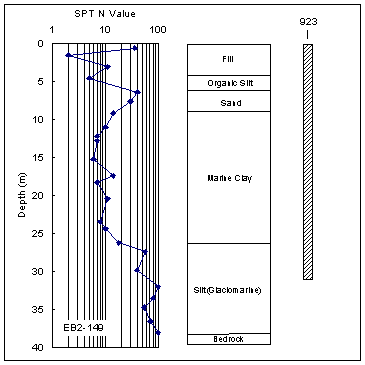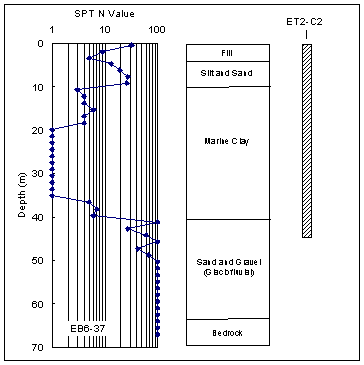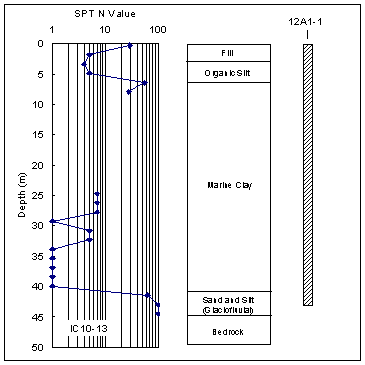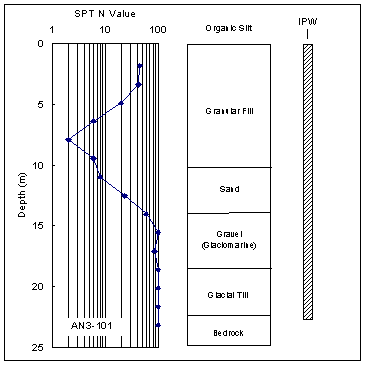U.S. Department of Transportation
Federal Highway Administration
1200 New Jersey Avenue, SE
Washington, DC 20590
202-366-4000
Federal Highway Administration Research and Technology
Coordinating, Developing, and Delivering Highway Transportation Innovations
 |
| This report is an archived publication and may contain dated technical, contact, and link information |
|
Publication Number:
FHWA-HRT-05-159
|
Previous | Table of Contents | Next
This chapter presents the pile design criteria and specifications used on the CA/T project in contracts C07D1, C07D2, C08A1, C09A4, and C19B1. These include information on the types of piles used, capacity requirements, minimum preaugering depths, and testing requirements. The subsurface conditions on which the design criteria were based are also discussed.
Representative soil profiles from each of the contract sites are shown in figures 2 through 6 based on the interpretation of geotechnical borings. (See references 4, 5, 6, 7, 8, 9, and 10)
As shown in figures 2 through 5, the conditions encountered at sites in East Boston (C07D1, C07D2, and C08A1) and in downtown Boston (C09A4) are similar. The subsurface conditions at these locations typically consisted of fill overlying layers of organic silt, inorganic sand or silt, marine clay, glacial soils, and bedrock. The subsurface conditions shown in figure 6 for the C19B1 site in Charlestown, however, were different from the other four sites. Organic soils and marine clays were only encountered to a limited extent at the site. Also, the thickness of the fill layer was greater relative to the other sites.
The physical properties and geological origin of the soils encountered at the contract sites are described below.(11-12)
Bedrock: The bedrock in the area consists of argillite from the Cambridge formation. The condition of the bedrock varies considerably with location, even within a given site. Evaluation of rock core samples indicates that the rock is typically in a soft and weathered condition and contains a significant amount of fracturing. However, hard and sound bedrock was found at some locations.
Glacial Soils: The glacial soils were deposited during the last glaciation approximately 12,000 years ago. These deposits include glacial till, and glaciomarine, glaciolacustrine, and glaciofluvial soils. Till is characterized by a mass of unsorted debris that contains angular particles composed of a wide variety of grain sizes, ranging from clay-sized particles to large boulders. Glaciomarine or glaciolacustrine deposits generally consist of clay, silt, and sand, whereas glaciofluvial deposits contain coarser grained sand and gravel. The glacial soils are typically dense in nature as indicated by high standard penetration test (SPT) resistance, and the piles were typically terminated in these deposits.
Marine Soils: Marine soils were deposited over the glacial soils during glacial retreat in a quiescent deepwater environment. The marine clay layer, as shown in figures 2 through 5, is the thickest unit in the profile, but was encountered only to a limited extent at the Charlestown site. The clay is generally overconsolidated in the upper portions of the layer and is characterized by relatively higher strengths. The overconsolidation is a result of past desiccation that occurred during a period of low sea level. By comparison, the deeper portions of the clay layer are much softer and penetration of the SPT split spoon can sometimes occur with just the weight of the drilling rods alone.
Inorganic Soils: Inorganic silts and sands are typically encountered overlying the marine soils. These soils were deposited by alluvial processes.
Organic Soils: The organic soils that are encountered below the fill generally consist of organic silt and may contain layers of peat or fine sand. These soils are the result of former tidal marshes that existed along the coastal areas.
Fill Soils: Fill material was placed in the more recent past to raise the grade for urban development. The fill layer is highly variable in its thickness and composition, ranging from silts and clays to sands and gravels. The consistency or density is also variable as indicated by the SPT blow counts. The variability in the fill is attributed to the characteristics of the particular borrow source material and the methods of placement.

Figure 2. Soil profile at the contract C07D1 site as encountered in Boring EB3-5.

Figure 3. Soil profile at the contract C07D2 site as encountered in Boring EB2-149.

Figure 4. Soil profile at the contract C08A1 site as encountered in Boring EB6-37.

Figure 5. Soil profile at the contract C09A4 site as encountered in Boring IC10-13.

Figure 6. Soil profile at the contract C19B1 site as encountered in Boring AN3-101.
The variable fill and compressible clay soils encountered at depth necessitated the use of deep foundations. Driven piles were selected, and design criteria and specifications were developed for their installation, ultimate capacity, and testing. Because the CA/T project was located in Massachusetts, the design criteria were required to satisfy the regulations given in the Massachusetts State building code.(13) The technical content of the State code is based on the 1993 edition of the Building Officials and Code Administrators (BOCA) national building code.
The specifications that were used for each CA/T contract are contained in two documents of the Massachusetts Highway Department (MHD). The first document includes the general requirements for all CA/T contracts and is entitled Supplemental Specifications and CA/T Supplemental Specifications to Construction Details of the Standard Specifications for Highways and Bridges (Division II) for Central Artery (I-93)/Tunnel (I-90) Project in the City of Boston.(14)
The specifications pertaining to individual contracts are covered in a second document concerning special provisions.(15) The special provisions are necessary given the uniqueness of the environmental conditions, soil conditions, and structure types found in each contract. The special provisions present specific details regarding the pile types, pile capacity requirements, and minimum preaugering depths.
Information selected from the specification regarding pile types, preaugering criteria, pile driving criteria, and axial load and test criteria is highlighted below.
Two types of piles were specified on the selected contracts of the CA/T: (1) PPC piles, and (2) concrete-filled steel pipe piles. The PPC piles were fabricated using 34.5- to 41.3-megapascal (MPa) (28-day strength) concrete and were prestressed to 5.2 to 8.3 MPa. The design drawings of typical 30-centimeter (cm)- and 41-cm-diameter square PPC piles are shown in figures 7 and 8, respectively.
To prevent damage to the pile tips during driving in very dense materials, the PPC piles were also fitted with 1.5-meter (m)-long steel H-pile "stingers." In the 41-cm-diameter PPC piles, an HP14x89 section was used as the stinger. The stingers were welded to a steel plate that was cast into the pile toe, as shown in figure 8. Stingers were used intermittently on the 30-;m-diameter PPC piles, consisting of HP10 by 42 sections.
The concrete-filled steel pipe piles were 31 to 61 cm in diameter, with wall thicknesses ranging from 0.95 to 1.3 cm. The piles were driven closed-ended by welding a steel cone or flat plate onto the pile tip prior to driving. Once the pile was driven to the required depth, the pile was filled with concrete.
A summary of the pile types used on the CA/T is given in table 2, along with the estimated quantities driven. The quantities are based on the contractor's bid quantities that were obtained directly from Bechtel/Parsons Brinckerhoff. As shown in table 2, the 41-cm-diameter PPC piles were the dominant pile type used, accounting for more than 70 percent of the total length of pile driven.
| Pile Type | Estimated Length of Pile Driven (m) | |||||
|---|---|---|---|---|---|---|
| C07D1 | C07D2 | C08A1 | C09A4 | C19B1 | Total | |
32-cm pipe |
- |
- |
- |
- |
5,550 |
5,550 |
41-cm pipe |
- |
- |
- |
5,578 |
- |
5,578 |
61-cm pipe |
- |
- |
- |
- |
296 |
296 |
30-cm square PPC |
7,969 |
3,981 |
792 |
3,658 |
2,177 |
18,577 |
41-cm square PPC |
32,918 |
19,879 |
8,406 |
14,326 |
6,279 |
81,808 |
Preaugering was specified for all piles that were installed in embankments or within the specified limits of adjacent structures. Settlement problems observed at the Hilton hotel (contract C07D1) initiated the use of preaugering to reduce the potential for soil heave caused by pile installation. Soil heave is discussed further in chapter 3. The required depth of preaugering varied depending on the contract and pile location, but ranged from 7.6 to 32.0 m below the ground surface.
The specifications required that a Wave Equation Analysis of Piles (WEAP) be used to select the pile driving equipment. The WEAP model estimates hammer performance, driving stresses, and driving resistance for an assumed hammer configuration, pile type, and soil profile. The acceptability of the hammer system was based on the successful demonstration that the pile could be driven to the required capacity or tip elevation without damage to the pile, within a penetration resistance of 3 to 15 blows per 2.5 cm.
The pile driving resistance criteria estimated from the WEAP analysis was also used as the initial driving criteria for the installation of the test piles. Additional WEAP analyses were required for changes in the hammer type, pile type or size, or for significant variations in the soil profile. It was also specified that the WEAP analyses be rerun with modifications to the input parameters to match the results obtained from the dynamic or static load test results. Modifications to the driving criteria could be made as appropriate, based on the results of the pile load tests.
1 foot = 0.30 m
1 inch = 25.4 mm
Figure 8. Typical pile details for a 41-cm-diameter PPC pile with stinger.
The required allowable axial capacities that were identified in the special provisions are summarized in table 3. Allowable axial load capacities ranged from 311 to 1,583 kilonewtons (kN). Lateral load criteria were not identified in the selected contracts.
| Pile Type | Required Allowable Axial Capacity (kN) |
|---|---|
32-cm pipe |
890 |
41-cm pipe |
1,583 |
61-cm pipe |
311 |
30-cm square PPC |
356–756 |
41-cm square PPC |
534–1,379 |
The axial capacity of the piles was verified using pile load tests, which were specified in section 940.62 of the general specifications.(14) The required ultimate capacities for the load tests were specified by applying a minimum factor of safety of 2.0 to the required allowable values. A factor of safety of 2.25 was specified in contract C19B1, which is consistent with the recommended American Association of State Highway and Transportation Officials (AASHTO) criteria for piles designed and evaluated based only on a subsurface exploration, static analysis, WEAP analysis, and dynamic pile testing.(16)
Dynamic load testing was required for test piles and for a portion of the production piles to monitor driving-induced stresses in the piles, evaluate hammer efficiency and performance, estimate the soil-resistance distribution, and evaluate the pile capacity during initial installation driving and restrikes. A waiting period of 12 to 36 hours (h) was required after pile installation before restrike tests could be performed.
Static load tests were required for test piles to confirm that the minimum specified allowable capacity was achieved and to better estimate or establish higher allowable design capacities. Section 1817.4.1 of the Massachusetts State building code says that the load reaching the top of the bearing stratum under maximum test load for a single pile or pile group must not be less than 100 percent of the allowable design load for end-bearing piles. Therefore, the specifications required that the static load test demonstrate that 100 percent of the design load was transferred to the bearing layer. If any of the test criteria were not met, the contractor was required to perform additional static load test(s).